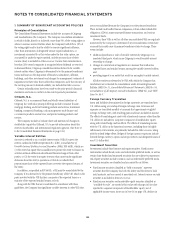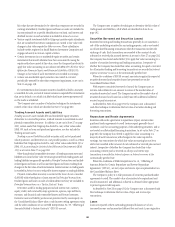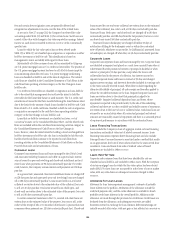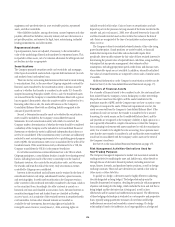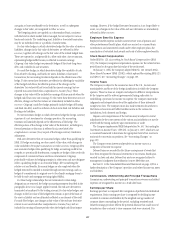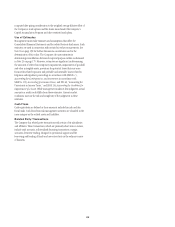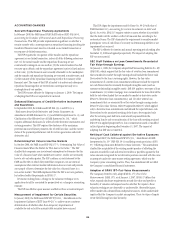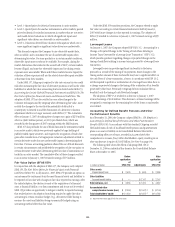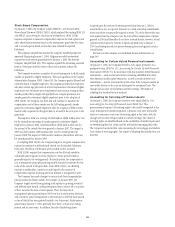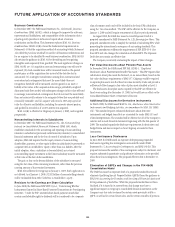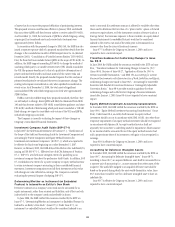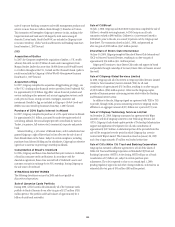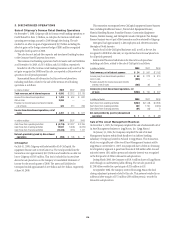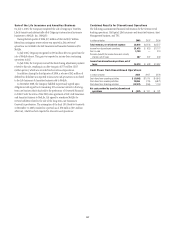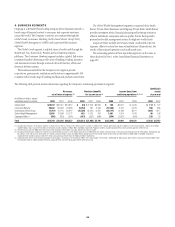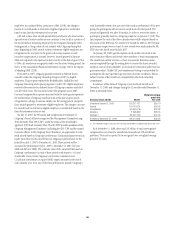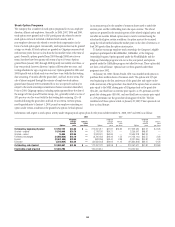Citibank 2008 Annual Report Download - page 138
Download and view the complete annual report
Please find page 138 of the 2008 Citibank annual report below. You can navigate through the pages in the report by either clicking on the pages listed below, or by using the keyword search tool below to find specific information within the annual report.FUTURE APPLICATION OF ACCOUNTING STANDARDS
Business Combinations
In December 2007, the FASB issued Statement No. 141(revised), Business
Combinations (SFAS 141(R)), which is designed to improve the relevance,
representational faithfulness, and comparability of the information that a
reporting entity provides in its financial reports about a business
combination and its effects. This Statement replaces SFAS 141, Business
Combinations. SFAS 141(R) retains the fundamental requirements in
Statement 141 that the acquisition method of accounting (which Statement
141 called the purchase method) be used for all business combinations and
for an acquirer to be identified for each business combination. SFAS 141(R)
also retains the guidance in SFAS 141 for identifying and recognizing
intangible assets separately from goodwill. The most significant changes in
SFAS 141(R) are: (1) acquisition costs and restructuring costs will now be
expensed; (2) stock consideration will be measured based on the quoted
market price as of the acquisition date instead of the date the deal is
announced; (3) contingent consideration arising from contractual and
noncontractual contingencies that meet the more-likely-than-not
recognition threshold will be measured and recognized as an asset or
liability at fair value at the acquisition date using a probability-weighted
discounted cash flows model, with subsequent changes in fair value reflected
in earnings; noncontractual contingencies that do not meet the more-likely-
than-not criteria will continue to be recognized when they are probable and
reasonably estimable; and (4) acquirer will record a 100% step-up to fair
value for all assets and liabilities, including the minority interest portion,
and goodwill is recorded as if a 100% interest was acquired.
SFAS 141(R) is effective for Citigroup on January 1, 2009, and is applied
prospectively.
Noncontrolling Interests in Subsidiaries
In December 2007, the FASB issued Statement No. 160, Noncontrolling
Interests in Consolidated Financial Statements (SFAS 160), which
establishes standards for the accounting and reporting of noncontrolling
interests in subsidiaries (previously called minority interests) in consolidated
financial statements and for the loss of control of subsidiaries. Upon
adoption, SFAS 160 requires that the equity interest of noncontrolling
shareholders, partners, or other equity holders in subsidiaries be presented as
a separate item in stockholders’ equity, rather than as a liability. After the
initial adoption, when a subsidiary is deconsolidated, any retained
noncontrolling equity investment in the former subsidiary must be measured
at fair value at the date of deconsolidation.
The gain or loss on the deconsolidation of the subsidiary is measured
using the fair value of the remaining investment, rather than the previous
carrying amount of that retained investment.
SFAS 160 is effective for Citigroup on January 1, 2009. Early application is
not allowed. As of January 1, 2009, $2.392 billion of noncontrolling interests
will be reclassified from Other liabilities to Stockholders’ equity.
Revisions to the Earnings per Share Calculation
In June 2008, the FASB issued FSP EITF 03-6-1, “Determining Whether
Instruments Granted in Share-Based Payment Transactions Are Participating
Securities.” Under the FSP, unvested share-based payment awards that
contain nonforfeitable rights to dividends will be considered to be a separate
class of common stock and will be included in the basic EPS calculation
using the “two-class method.” The FSP will be effective for the Company on
January 1, 2009 and will require restatement of all prior periods presented.
In August 2008, the FASB also issued a revised Exposure Draft of a
proposed amendment to FASB Statement No. 128, Earnings per Share. This
proposed amendment seeks to simplify the method of calculating EPS, while
promoting the international convergence of accounting standards. This
proposed amendment reaffirms the requirements of FSP EITF 03-6-1 for
basic EPS and also changes the calculation of diluted EPS. The Exposure
Draft does not contain an effective date.
The Company is currently evaluating the impact of these changes.
Fair Value Disclosures about Pension Plan Assets
In December 2008, the FASB issued FSP FAS 132(R)-1, “Employers’
Disclosures about Postretirement Benefit Plan Assets.” This FSP requires that
information about plan assets be disclosed, on an annual basis, based on the
fair value disclosure requirements of SFAS 157. Citigroup would be required
to separate plan assets into the three fair value hierarchy levels and provide a
rollforward of the changes in fair value of plan assets classified as Level 3.
The disclosures about plan assets required by this FSP are effective for
fiscal years ending after December 15, 2009, but would have no effect on the
Consolidated Balance Sheet or Statement of Income.
Additional Disclosures for Derivative Instruments
In March 2008, the FASB issued SFAS No. 161, Disclosures about Derivative
Instruments and Hedging Activities, an amendment to SFAS 133 (SFAS
161). The standard requires enhanced disclosures about derivative
instruments and hedged items that are accounted for under SFAS 133 and
related interpretations. The standard will be effective for all of the Company’s
interim and annual financial statements beginning with the first quarter of
2009. The standard expands the disclosure requirements for derivatives and
hedged items and has no impact on how Citigroup accounts for these
instruments.
Loss-Contingency Disclosures
In June 2008, the FASB issued an exposure draft proposing expanded
disclosures regarding loss contingencies accounted for under FASB
Statement No. 5, Accounting for Contingencies, and SFAS 141(R). This
proposal increases the number of loss contingencies subject to disclosure and
requires substantial quantitative and qualitative information to be provided
about those loss contingencies. The proposed effective date is December 31,
2009.
Elimination of QSPEs and Changes in the FIN 46(R)
Consolidation Model
The FASB has issued an exposure draft of a proposed standard that would
eliminate Qualifying Special Purpose Entities (QSPEs) from the guidance in
SFAS 140, Accounting for Transfers and Servicing of Financial Assets and
Extinguishments of Liabilities. While the proposed standard has not been
finalized, if it is issued in its current form, this change may have a
significant impact on Citigroup’s consolidated financial statements as the
Company may lose sales treatment for certain assets previously sold to a
QSPE, as well as for certain future sales, and for certain transfers of portions
132


